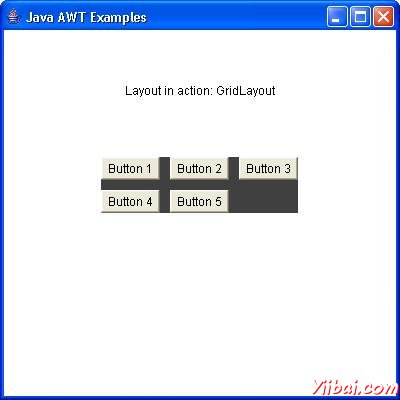AWTGridLayout
介紹
GridLayout 類元件排列在一個長方形的網格。
類的宣告
以下是宣告的java.awt.GridLayout類:
public class GridLayout extends Object implements LayoutManager, Serializable
類別建構函式
| S.N. | 建構函式與說明 |
|---|---|
| 1 |
GridLayout() Creates a grid layout with a default of one column per component, in a single row. |
| 2 |
GridLayout(int rows, int cols) Creates a grid layout with the specified number of rows and columns. |
| 3 |
GridLayout(int rows, int cols, int hgap, int vgap) Creates a grid layout with the specified number of rows and columns. |
類方法
| S.N. | 方法和說明 |
|---|---|
| 1 |
void addLayoutComponent(String name, Component comp) Adds the specified component with the specified name to the layout. |
| 2 |
int getColumns() Gets the number of columns in this layout. |
| 3 |
int getHgap() Gets the horizontal gap between components. |
| 4 |
int getRows() Gets the number of rows in this layout. |
| 5 |
int getVgap() Gets the vertical gap between components. |
| 6 |
void layoutContainer(Container parent) Lays out the specified container using this layout. |
| 7 |
Dimension minimumLayoutSize(Container parent) Determines the minimum size of the container argument using this grid layout. |
| 8 |
Dimension preferredLayoutSize(Container parent) Determines the preferred size of the container argument using this grid layout. |
| 9 |
void removeLayoutComponent(Component comp) Removes the specified component from the layout. |
| 10 |
void setColumns(int cols) Sets the number of columns in this layout to the specified value. |
| 11 |
void setHgap(int hgap) Sets the horizontal gap between components to the specified value. |
| 12 |
void setRows(int rows) Sets the number of rows in this layout to the specified value. |
| 13 |
void setVgap(int vgap) Sets the vertical gap between components to the specified value. |
| 14 |
String toString() Returns the string representation of this grid layout's values. |
繼承的方法
這個類繼承的方法從以下類:
-
java.lang.Object
GridLayout 範例
在選擇使用任何編輯器建立以下java程式D:/ > AWT > com > yiibai > gui >
AwtLayoutDemopackage com.yiibai.gui; import java.awt.*; import java.awt.event.*; public class AwtLayoutDemo { private Frame mainFrame; private Label headerLabel; private Label statusLabel; private Panel controlPanel; private Label msglabel; public AwtLayoutDemo(){ prepareGUI(); } public static void main(String[] args){ AwtLayoutDemo awtLayoutDemo = new AwtLayoutDemo(); awtLayoutDemo.showGridLayoutDemo(); } private void prepareGUI(){ mainFrame = new Frame("Java AWT Examples"); mainFrame.setSize(400,400); mainFrame.setLayout(new GridLayout(3, 1)); mainFrame.addWindowListener(new WindowAdapter() { public void windowClosing(WindowEvent windowEvent){ System.exit(0); } }); headerLabel = new Label(); headerLabel.setAlignment(Label.CENTER); statusLabel = new Label(); statusLabel.setAlignment(Label.CENTER); statusLabel.setSize(350,100); msglabel = new Label(); msglabel.setAlignment(Label.CENTER); msglabel.setText("Welcome to TutorialsPoint AWT Tutorial."); controlPanel = new Panel(); controlPanel.setLayout(new FlowLayout()); mainFrame.add(headerLabel); mainFrame.add(controlPanel); mainFrame.add(statusLabel); mainFrame.setVisible(true); } private void showGridLayoutDemo(){ headerLabel.setText("Layout in action: GridLayout"); Panel panel = new Panel(); panel.setBackground(Color.darkGray); panel.setSize(300,300); GridLayout layout = new GridLayout(0,3); layout.setHgap(10); layout.setVgap(10); panel.setLayout(layout); panel.add(new Button("Button 1")); panel.add(new Button("Button 2")); panel.add(new Button("Button 3")); panel.add(new Button("Button 4")); panel.add(new Button("Button 5")); controlPanel.add(panel); mainFrame.setVisible(true); } }
編譯程式,使用命令提示字元。進入到D:/> AWT,然後鍵入以下命令。
D:AWT>javac comyiibaiguiAwtlayoutDemo.java
如果沒有錯誤出現,這意味著編譯成功。使用下面的命令來執行程式。
D:AWT>java com.yiibai.gui.AwtlayoutDemo
驗證下面的輸出
